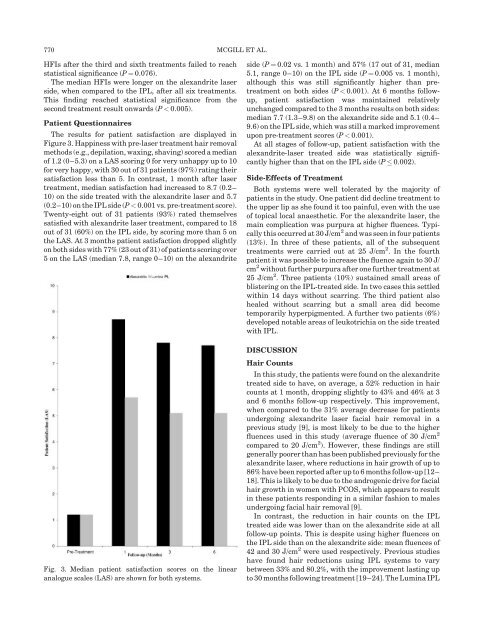Fallstudie - Sundsvalls Laserklinik
Fallstudie - Sundsvalls Laserklinik
Fallstudie - Sundsvalls Laserklinik
You also want an ePaper? Increase the reach of your titles
YUMPU automatically turns print PDFs into web optimized ePapers that Google loves.
770 MCGILL ET AL.<br />
HFIs after the third and sixth treatments failed to reach<br />
statistical significance (P ¼ 0.076).<br />
The median HFIs were longer on the alexandrite laser<br />
side, when compared to the IPL, after all six treatments.<br />
This finding reached statistical significance from the<br />
second treatment result onwards (P < 0.005).<br />
Patient Questionnaires<br />
The results for patient satisfaction are displayed in<br />
Figure 3. Happiness with pre-laser treatment hair removal<br />
methods (e.g., depilation, waxing, shaving) scored a median<br />
of 1.2 (0–5.3) on a LAS scoring 0 for very unhappy up to 10<br />
for very happy, with 30 out of 31 patients (97%) rating their<br />
satisfaction less than 5. In contrast, 1 month after laser<br />
treatment, median satisfaction had increased to 8.7 (0.2–<br />
10) on the side treated with the alexandrite laser and 5.7<br />
(0.2–10) on the IPL side (P < 0.001 vs. pre-treatment score).<br />
Twenty-eight out of 31 patients (93%) rated themselves<br />
satisfied with alexandrite laser treatment, compared to 18<br />
out of 31 (60%) on the IPL side, by scoring more than 5 on<br />
the LAS. At 3 months patient satisfaction dropped slightly<br />
on both sides with 77% (23 out of 31) of patients scoring over<br />
5 on the LAS (median 7.8, range 0–10) on the alexandrite<br />
Fig. 3. Median patient satisfaction scores on the linear<br />
analogue scales (LAS) are shown for both systems.<br />
side (P ¼ 0.02 vs. 1 month) and 57% (17 out of 31, median<br />
5.1, range 0–10) on the IPL side (P ¼ 0.005 vs. 1 month),<br />
although this was still significantly higher than pretreatment<br />
on both sides (P < 0.001). At 6 months followup,<br />
patient satisfaction was maintained relatively<br />
unchanged compared to the 3 months results on both sides:<br />
median 7.7 (1.3–9.8) on the alexandrite side and 5.1 (0.4–<br />
9.6) on the IPL side, which was still a marked improvement<br />
upon pre-treatment scores (P < 0.001).<br />
At all stages of follow-up, patient satisfaction with the<br />
alexandrite-laser treated side was statistically significantly<br />
higher than that on the IPL side (P 0.002).<br />
Side-Effects of Treatment<br />
Both systems were well tolerated by the majority of<br />
patients in the study. One patient did decline treatment to<br />
the upper lip as she found it too painful, even with the use<br />
of topical local anaesthetic. For the alexandrite laser, the<br />
main complication was purpura at higher fluences. Typically<br />
this occurred at 30 J/cm 2 and was seen in four patients<br />
(13%). In three of these patients, all of the subsequent<br />
treatments were carried out at 25 J/cm 2 . In the fourth<br />
patient it was possible to increase the fluence again to 30 J/<br />
cm 2 without further purpura after one further treatment at<br />
25 J/cm 2 . Three patients (10%) sustained small areas of<br />
blistering on the IPL-treated side. In two cases this settled<br />
within 14 days without scarring. The third patient also<br />
healed without scarring but a small area did become<br />
temporarily hyperpigmented. A further two patients (6%)<br />
developed notable areas of leukotrichia on the side treated<br />
with IPL.<br />
DISCUSSION<br />
Hair Counts<br />
In this study, the patients were found on the alexandrite<br />
treated side to have, on average, a 52% reduction in hair<br />
counts at 1 month, dropping slightly to 43% and 46% at 3<br />
and 6 months follow-up respectively. This improvement,<br />
when compared to the 31% average decrease for patients<br />
undergoing alexandrite laser facial hair removal in a<br />
previous study [9], is most likely to be due to the higher<br />
fluences used in this study (average fluence of 30 J/cm 2<br />
compared to 20 J/cm 2 ). However, these findings are still<br />
generally poorer than has been published previously for the<br />
alexandrite laser, where reductions in hair growth of up to<br />
86% have been reported after up to 6 months follow-up [12–<br />
18]. This is likely to be due to the androgenic drive for facial<br />
hair growth in women with PCOS, which appears to result<br />
in these patients responding in a similar fashion to males<br />
undergoing facial hair removal [9].<br />
In contrast, the reduction in hair counts on the IPL<br />
treated side was lower than on the alexandrite side at all<br />
follow-up points. This is despite using higher fluences on<br />
the IPL side than on the alexandrite side: mean fluences of<br />
42 and 30 J/cm 2 were used respectively. Previous studies<br />
have found hair reductions using IPL systems to vary<br />
between 33% and 80.2%, with the improvement lasting up<br />
to 30 months following treatment [19–24]. The Lumina IPL


